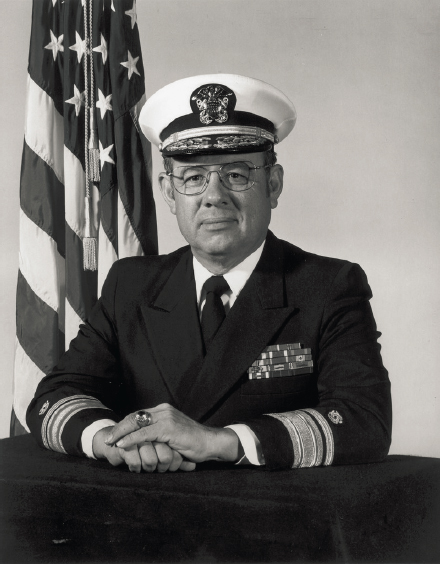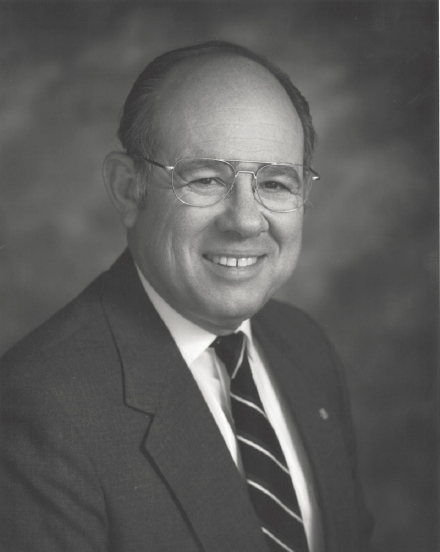

BENJAMIN F. MONTOYA
1935–2015
Elected in 2001
“For environmental and organizational leadership in both the US Navy and public power sector while maintaining total dedication to societal values.”
SUBMITTED BY THE NAE HOME SECRETARY
BENJAMIN FRANKLIN MONTOYA, 80, died December 19, 2015, in Fairfield, California, at age 80. He was buried with military honors at Coachella Valley Cemetery.
Ben was born May 24, 1935, in Indio, CA, to immigrant farm workers Benjamin C. and Margarita Ramirez Montoya. A gifted student, accomplished athlete, and Associated Student Body president at Coachella Valley High School, he went on to attend California State Polytechnic Institute in San Luis Obispo for a year before being appointed midshipman at the United States Naval Academy. He graduated in 1958 with a general BS degree, was commissioned as an ensign in the Civil Engineer Corps, and married his high school sweetheart, Virginia Cox.
Admiral Montoya’s 32-year naval career began that year with a tour as assistant shops engineer at Naval Air Station Miramar in California. Following this tour he attended Rensselaer Polytechnic Institute, where in 1960 he received
___________________
This tribute is based on text submitted by the Naval Facilities Engineering Command Staff, a National Academy of Construction tribute (https://www.naocon.org/members/montoyaben/) prepared by Jack Buffington (NAE), input from Michael R. Johnson (NAE), and a brief biography posted by the US Naval Academy (https://www.usna.com/document.doc?id=280).
a bachelor of science degree in civil engineering, as was customary in the Navy for more specialized education. Follow-on tours took him back to California, with assignments in Long Beach and Port Hueneme.
Naval Mobile Construction Battalion Three (NMCB 3) in Guam was his next stop, where he got his first taste of life with the Seabees, serving as intelligence, training, and eventually operations officer. While serving with NMCB 3, he deployed twice to Vietnam—Da Nang in 1965, where he led an advance party to supervise the construction of the first base camp built by Seabees, and Chu Lai in 1966, where he participated in the construction of a base camp, supply point, hospital, and Marine Corps helicopter base. For his Vietnam service, Lieutenant Montoya earned the Bronze Star with Combat “V” and the Navy Commendation Medal. He was promoted to lieutenant commander (LCDR).
In 1967 he enrolled at Georgia Tech, where he earned a master of science degree in sanitary engineering and environmental studies in 1968, knowledge that he applied in assignments as public works officer at Naval Station San Juan in Puerto Rico and as command ecology officer of the Western Division of Naval Facilities Engineering Command (NAVFAC) in San Bruno.
In 1973 he was promoted to commander and the following year relocated to Washington, DC, where he became director of the Environmental Quality Division and Environmental Protection Officer at NAVFAC headquarters. In this role, with responsibility for environmental compliance, he led the Navy to understand the problem and take the difficult but necessary steps toward compliance. He earned a law degree from Georgetown University to familiarize himself with the legal as well as physical aspects of compliance, and in 1981 was admitted to the District of Columbia Bar. The Army, Air Force, and other branches of the service, as well as many federal agencies, followed suit leaning on Ben’s leadership and effectiveness.
During tours in Hawaii and California he rose through the ranks and in 1986 Commodore Montoya returned to Washington as director of the Shore Activities Division in the
Office of the Deputy Chief of Naval Operations. The next year he was promoted to rear admiral (upper half) and reached the pinnacle of his career when he succeeded Rear Admiral John Paul Jones Jr. as commander of NAVFAC and chief of civil engineers.
An important feature of RADM Montoya’s tenure as NAVFAC commander was the development of a culture of innovation through a partnership with the Construction Industry Institute (CII). NAVFAC commissioned CII studies to evaluate new initiatives, such as constructability. The practice of sending promising young NAVFAC officers to work on relevant graduate degrees and use NAVFAC projects to gather data for their theses and dissertations was encouraged. The results were presented to key groups for possible implementation. (One such presentation was in the rehearsal stage in the Pentagon a few doors from the location of the plane strike on 9/11.)
In 1989, after more than 3 decades of dedicated service, Rear Admiral Montoya retired from active duty. He pursued a civilian career in the utility industry, first at Pacific Gas and Electric in San Francisco, where he became a senior vice president and general manager of the gas supply business unit. In 1993 he became president and CEO of the Public Service Company of New Mexico (the state’s major utility) and chair of the board in 1999.
For the National Academy of Engineering, he served on the Committee on the Diversity of the Engineering Workforce (2001–02), and in 2006 he was appointed to the NASA Advisory Council as a member of the Space Operations Committee. He also served on many civic boards, including the National Parks Foundation, California State Board of Education, Albuquerque Community Foundation, United Way of Greater Albuquerque, and New Mexico State University Business Advisory Council.
In all his endeavors Ben was a leader who compelled every participant in the task, committee, or board to perform well beyond expectations. Whether he was chair or team member, he took charge and accepted only the finest performance from everyone. His work ethic was contagious.
Civilian honors included selection as US Hispanic Engineer of the Year (1989), presidential appointment to the US Naval Academy Board of Visitors (1995–96) and Base Realignment and Closure Commission (1995), 1997 Executive of the Year—National Hispanic Employee Association, and 1998 induction into the Hispanic Engineer National Achievement Awards Conference Hall of Fame. He was elected to the NAE in 2001, and in 2006 to the National Academy of Construction (NAC) for his work on the Navy’s major shore facilities environmental restoration program.
Ben was described as “a man of action,” with “great personal integrity and a high sense of honor.” He also had a strong but quiet faith.
He was diagnosed with cancer in 2013 but for 2 years he was able to continue enjoying a full life in retirement. He was survived by his wife of 57 years, Ginney (she died in 2020); their sons Ben, Chris, Pat, Mike, and Dave and daughters Terri and Natasha; 17 grandchildren; and 3 great-grandchildren.
More than all of his many career accomplishments, Ben Montoya deeply touched the lives of many and will be greatly missed.






